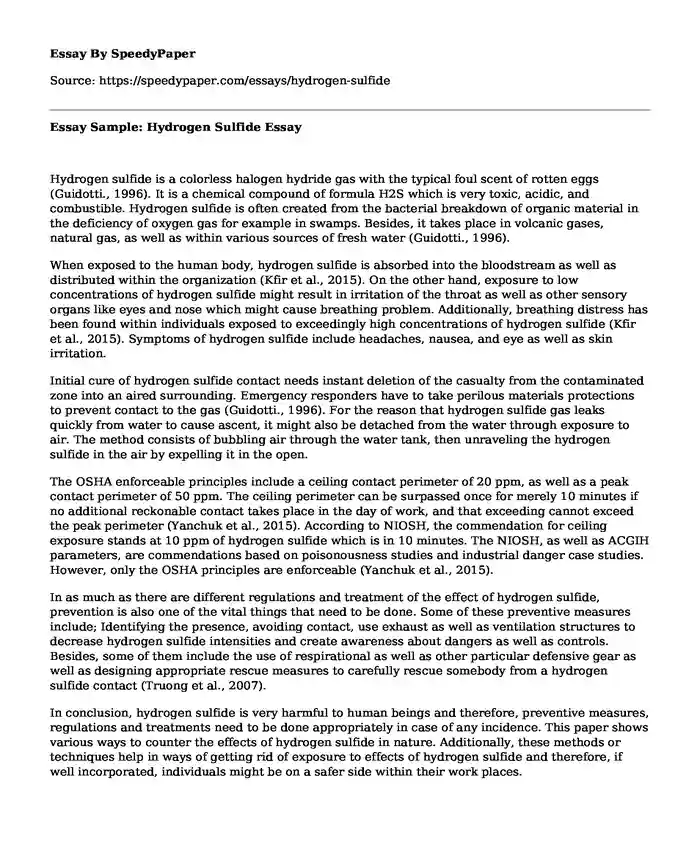Hydrogen sulfide is a colorless halogen hydride gas with the typical foul scent of rotten eggs (Guidotti., 1996). It is a chemical compound of formula H2S which is very toxic, acidic, and combustible. Hydrogen sulfide is often created from the bacterial breakdown of organic material in the deficiency of oxygen gas for example in swamps. Besides, it takes place in volcanic gases, natural gas, as well as within various sources of fresh water (Guidotti., 1996).
When exposed to the human body, hydrogen sulfide is absorbed into the bloodstream as well as distributed within the organization (Kfir et al., 2015). On the other hand, exposure to low concentrations of hydrogen sulfide might result in irritation of the throat as well as other sensory organs like eyes and nose which might cause breathing problem. Additionally, breathing distress has been found within individuals exposed to exceedingly high concentrations of hydrogen sulfide (Kfir et al., 2015). Symptoms of hydrogen sulfide include headaches, nausea, and eye as well as skin irritation.
Initial cure of hydrogen sulfide contact needs instant deletion of the casualty from the contaminated zone into an aired surrounding. Emergency responders have to take perilous materials protections to prevent contact to the gas (Guidotti., 1996). For the reason that hydrogen sulfide gas leaks quickly from water to cause ascent, it might also be detached from the water through exposure to air. The method consists of bubbling air through the water tank, then unraveling the hydrogen sulfide in the air by expelling it in the open.
The OSHA enforceable principles include a ceiling contact perimeter of 20 ppm, as well as a peak contact perimeter of 50 ppm. The ceiling perimeter can be surpassed once for merely 10 minutes if no additional reckonable contact takes place in the day of work, and that exceeding cannot exceed the peak perimeter (Yanchuk et al., 2015). According to NIOSH, the commendation for ceiling exposure stands at 10 ppm of hydrogen sulfide which is in 10 minutes. The NIOSH, as well as ACGIH parameters, are commendations based on poisonousness studies and industrial danger case studies. However, only the OSHA principles are enforceable (Yanchuk et al., 2015).
In as much as there are different regulations and treatment of the effect of hydrogen sulfide, prevention is also one of the vital things that need to be done. Some of these preventive measures include; Identifying the presence, avoiding contact, use exhaust as well as ventilation structures to decrease hydrogen sulfide intensities and create awareness about dangers as well as controls. Besides, some of them include the use of respirational as well as other particular defensive gear as well as designing appropriate rescue measures to carefully rescue somebody from a hydrogen sulfide contact (Truong et al., 2007).
In conclusion, hydrogen sulfide is very harmful to human beings and therefore, preventive measures, regulations and treatments need to be done appropriately in case of any incidence. This paper shows various ways to counter the effects of hydrogen sulfide in nature. Additionally, these methods or techniques help in ways of getting rid of exposure to effects of hydrogen sulfide and therefore, if well incorporated, individuals might be on a safer side within their work places.
References
Doujaiji, B., & Al-Tawfiq, J. A. (2010). Hydrogen sulfide exposure in an adult male. Annals of Saudi medicine, 30(1), 76.Guidotti, T. L. (1996). Hydrogen sulphide. Occupational Medicine, 46(5), 367-371.
Kfir, H., Rimbrot, S., & Markel, A. (2015). Toxic effects of hydrogen sulfide: experience with three simultaneous patients. QJM: An International Journal of Medicine, 108(12), 977-978.
Truong, D. H., Mihajlovic, A., Gunness, P., Hindmarsh, W., & O'Brien, P. J. (2007). Prevention of hydrogen sulfide (H2S)-induced mouse lethality and cytotoxicity by hydroxocobalamin (vitamin B12a). Toxicology, 242(1-3), 16-22.
Yanchuk, P. I., & Slobodianyk, L. A. (2015). The role of hydrogen sulfide in regulation of circulation blood liver. Fiziolohichnyi zhurnal (Kiev, Ukraine: 1994), 61(3), 28-34.
Cite this page
Essay Sample: Hydrogen Sulfide. (2022, Dec 09). Retrieved from https://speedypaper.com/essays/hydrogen-sulfide
Request Removal
If you are the original author of this essay and no longer wish to have it published on the SpeedyPaper website, please click below to request its removal:
- Personal Narrative Essay Example
- Modernism in The Waste Land - Free Essay in Literature
- Research Paper Sample on Neuroscience and Cinema: Cinema, Cognition, and Art
- Free Paper about the Internet Differential Equation Activities
- Patriarchy: A Social System of Power and Inequality
- First Amendment and Freedom of Speech
- Free Essay Example. Synopsis of Audiotopia
Popular categories





